Finance in Hospitality Industry: Cost Analysis and Budgeting Report
VerifiedAdded on 2020/10/04
|12
|3978
|114
Report
AI Summary
This report delves into the financial intricacies of the hospitality industry, focusing on cost analysis, budgeting, and stock control. The report begins by identifying the elements of costs and gross profit margins, along with operating expenses, within a restaurant setting. It then examines stock control and cash management techniques essential for business operations. A key component involves the preparation of a trial balance and a balance sheet for Alina Ltd, followed by an exploration of budgetary control processes and their purpose. Furthermore, the report analyzes financial performance, comparing two restaurants, Tai and Wasabi, and offers recommendations for improving business performance. The analysis covers various aspects of financial management, from cost classification to inventory management and cash flow strategies, providing a comprehensive overview of financial practices in the hospitality sector.
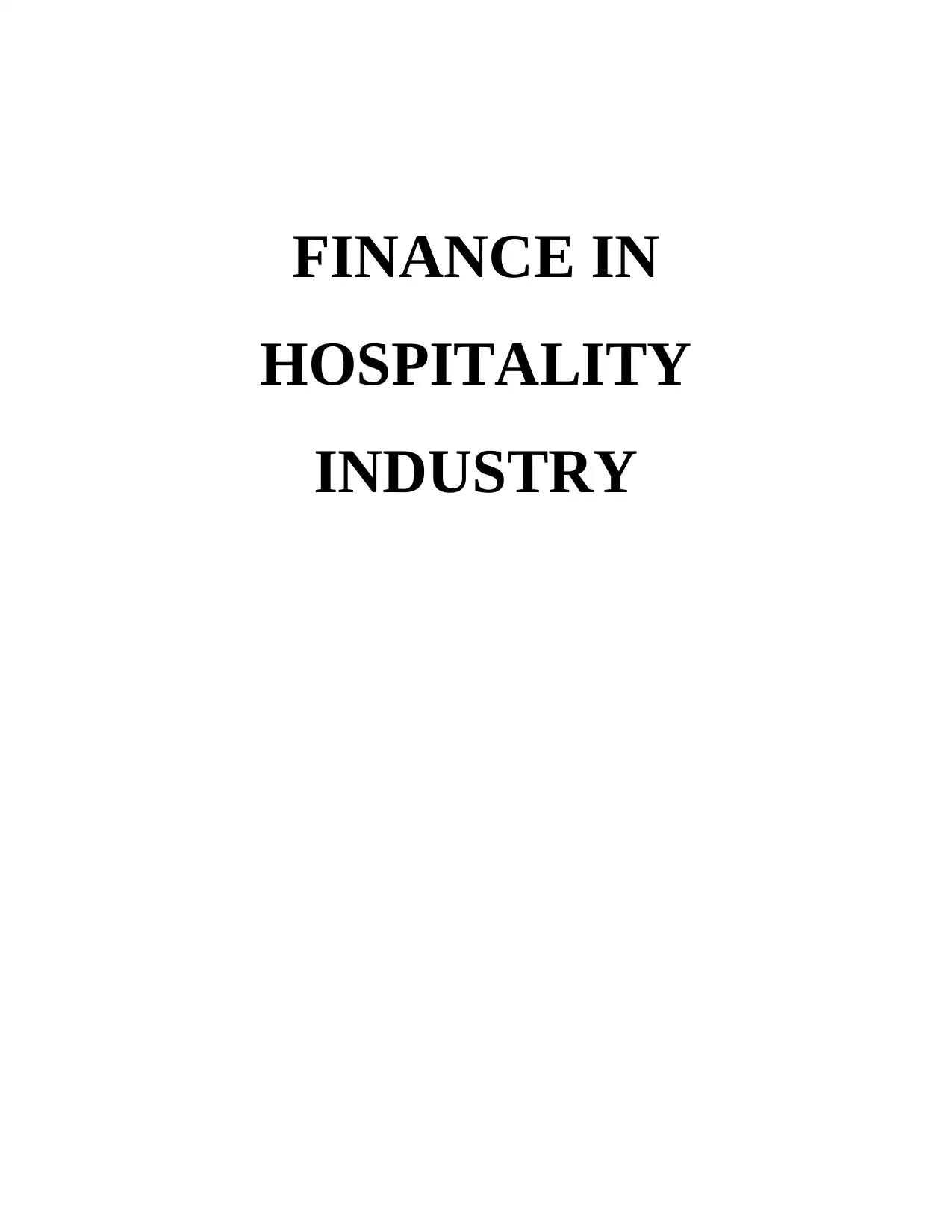
FINANCE IN
HOSPITALITY
INDUSTRY
HOSPITALITY
INDUSTRY
Paraphrase This Document
Need a fresh take? Get an instant paraphrase of this document with our AI Paraphraser
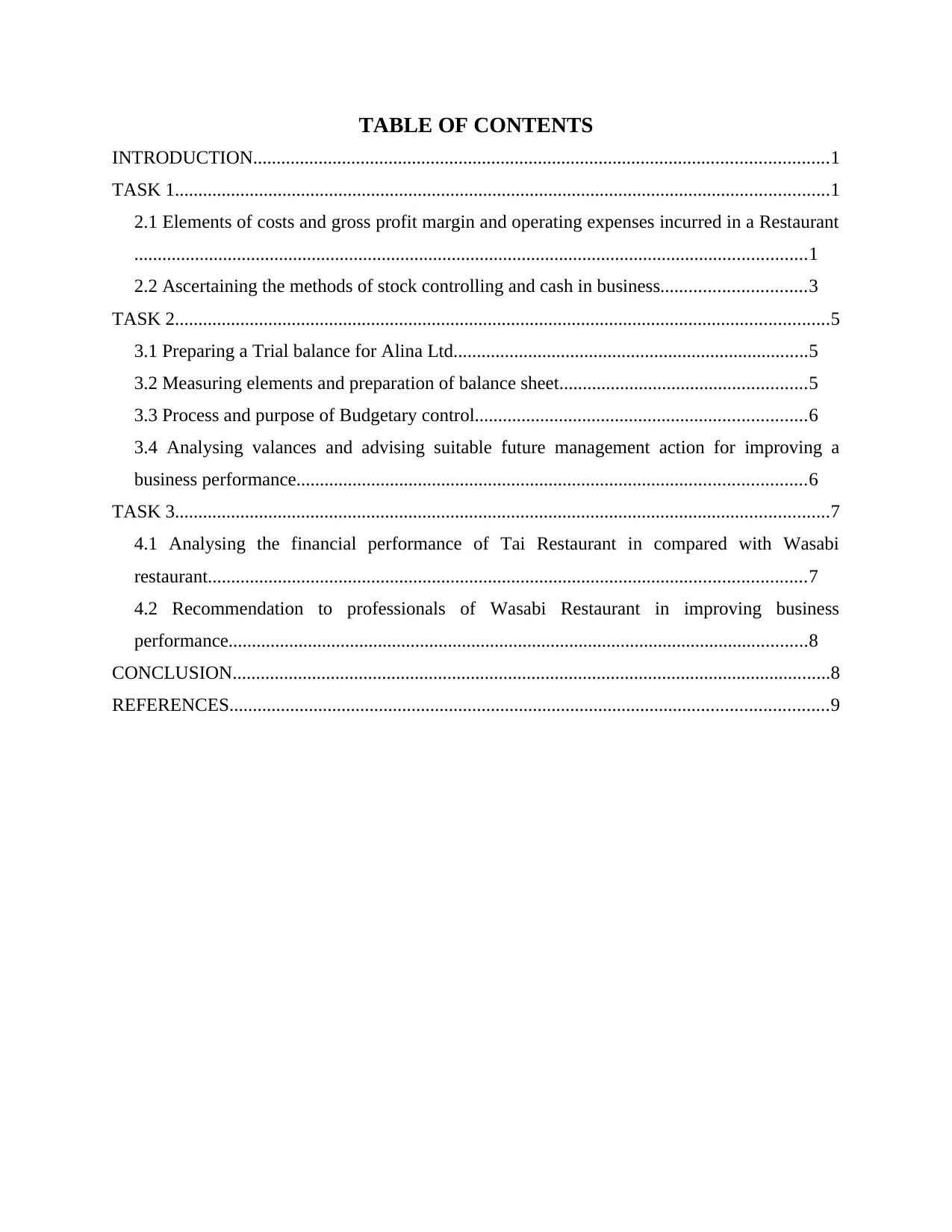
TABLE OF CONTENTS
INTRODUCTION...........................................................................................................................1
TASK 1............................................................................................................................................1
2.1 Elements of costs and gross profit margin and operating expenses incurred in a Restaurant
................................................................................................................................................1
2.2 Ascertaining the methods of stock controlling and cash in business...............................3
TASK 2............................................................................................................................................5
3.1 Preparing a Trial balance for Alina Ltd............................................................................5
3.2 Measuring elements and preparation of balance sheet.....................................................5
3.3 Process and purpose of Budgetary control.......................................................................6
3.4 Analysing valances and advising suitable future management action for improving a
business performance.............................................................................................................6
TASK 3............................................................................................................................................7
4.1 Analysing the financial performance of Tai Restaurant in compared with Wasabi
restaurant................................................................................................................................7
4.2 Recommendation to professionals of Wasabi Restaurant in improving business
performance............................................................................................................................8
CONCLUSION................................................................................................................................8
REFERENCES................................................................................................................................9
INTRODUCTION...........................................................................................................................1
TASK 1............................................................................................................................................1
2.1 Elements of costs and gross profit margin and operating expenses incurred in a Restaurant
................................................................................................................................................1
2.2 Ascertaining the methods of stock controlling and cash in business...............................3
TASK 2............................................................................................................................................5
3.1 Preparing a Trial balance for Alina Ltd............................................................................5
3.2 Measuring elements and preparation of balance sheet.....................................................5
3.3 Process and purpose of Budgetary control.......................................................................6
3.4 Analysing valances and advising suitable future management action for improving a
business performance.............................................................................................................6
TASK 3............................................................................................................................................7
4.1 Analysing the financial performance of Tai Restaurant in compared with Wasabi
restaurant................................................................................................................................7
4.2 Recommendation to professionals of Wasabi Restaurant in improving business
performance............................................................................................................................8
CONCLUSION................................................................................................................................8
REFERENCES................................................................................................................................9
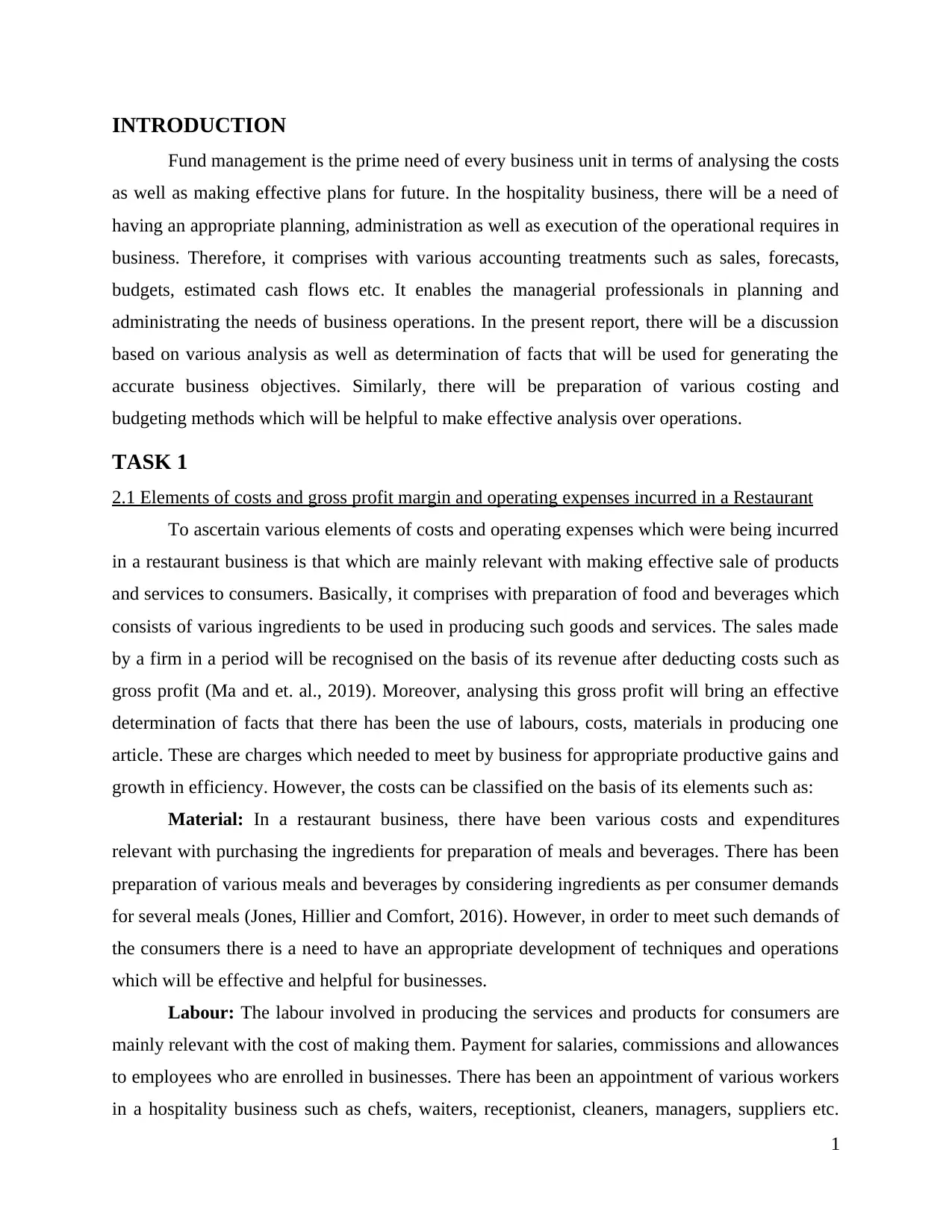
INTRODUCTION
Fund management is the prime need of every business unit in terms of analysing the costs
as well as making effective plans for future. In the hospitality business, there will be a need of
having an appropriate planning, administration as well as execution of the operational requires in
business. Therefore, it comprises with various accounting treatments such as sales, forecasts,
budgets, estimated cash flows etc. It enables the managerial professionals in planning and
administrating the needs of business operations. In the present report, there will be a discussion
based on various analysis as well as determination of facts that will be used for generating the
accurate business objectives. Similarly, there will be preparation of various costing and
budgeting methods which will be helpful to make effective analysis over operations.
TASK 1
2.1 Elements of costs and gross profit margin and operating expenses incurred in a Restaurant
To ascertain various elements of costs and operating expenses which were being incurred
in a restaurant business is that which are mainly relevant with making effective sale of products
and services to consumers. Basically, it comprises with preparation of food and beverages which
consists of various ingredients to be used in producing such goods and services. The sales made
by a firm in a period will be recognised on the basis of its revenue after deducting costs such as
gross profit (Ma and et. al., 2019). Moreover, analysing this gross profit will bring an effective
determination of facts that there has been the use of labours, costs, materials in producing one
article. These are charges which needed to meet by business for appropriate productive gains and
growth in efficiency. However, the costs can be classified on the basis of its elements such as:
Material: In a restaurant business, there have been various costs and expenditures
relevant with purchasing the ingredients for preparation of meals and beverages. There has been
preparation of various meals and beverages by considering ingredients as per consumer demands
for several meals (Jones, Hillier and Comfort, 2016). However, in order to meet such demands of
the consumers there is a need to have an appropriate development of techniques and operations
which will be effective and helpful for businesses.
Labour: The labour involved in producing the services and products for consumers are
mainly relevant with the cost of making them. Payment for salaries, commissions and allowances
to employees who are enrolled in businesses. There has been an appointment of various workers
in a hospitality business such as chefs, waiters, receptionist, cleaners, managers, suppliers etc.
1
Fund management is the prime need of every business unit in terms of analysing the costs
as well as making effective plans for future. In the hospitality business, there will be a need of
having an appropriate planning, administration as well as execution of the operational requires in
business. Therefore, it comprises with various accounting treatments such as sales, forecasts,
budgets, estimated cash flows etc. It enables the managerial professionals in planning and
administrating the needs of business operations. In the present report, there will be a discussion
based on various analysis as well as determination of facts that will be used for generating the
accurate business objectives. Similarly, there will be preparation of various costing and
budgeting methods which will be helpful to make effective analysis over operations.
TASK 1
2.1 Elements of costs and gross profit margin and operating expenses incurred in a Restaurant
To ascertain various elements of costs and operating expenses which were being incurred
in a restaurant business is that which are mainly relevant with making effective sale of products
and services to consumers. Basically, it comprises with preparation of food and beverages which
consists of various ingredients to be used in producing such goods and services. The sales made
by a firm in a period will be recognised on the basis of its revenue after deducting costs such as
gross profit (Ma and et. al., 2019). Moreover, analysing this gross profit will bring an effective
determination of facts that there has been the use of labours, costs, materials in producing one
article. These are charges which needed to meet by business for appropriate productive gains and
growth in efficiency. However, the costs can be classified on the basis of its elements such as:
Material: In a restaurant business, there have been various costs and expenditures
relevant with purchasing the ingredients for preparation of meals and beverages. There has been
preparation of various meals and beverages by considering ingredients as per consumer demands
for several meals (Jones, Hillier and Comfort, 2016). However, in order to meet such demands of
the consumers there is a need to have an appropriate development of techniques and operations
which will be effective and helpful for businesses.
Labour: The labour involved in producing the services and products for consumers are
mainly relevant with the cost of making them. Payment for salaries, commissions and allowances
to employees who are enrolled in businesses. There has been an appointment of various workers
in a hospitality business such as chefs, waiters, receptionist, cleaners, managers, suppliers etc.
1
⊘ This is a preview!⊘
Do you want full access?
Subscribe today to unlock all pages.

Trusted by 1+ million students worldwide
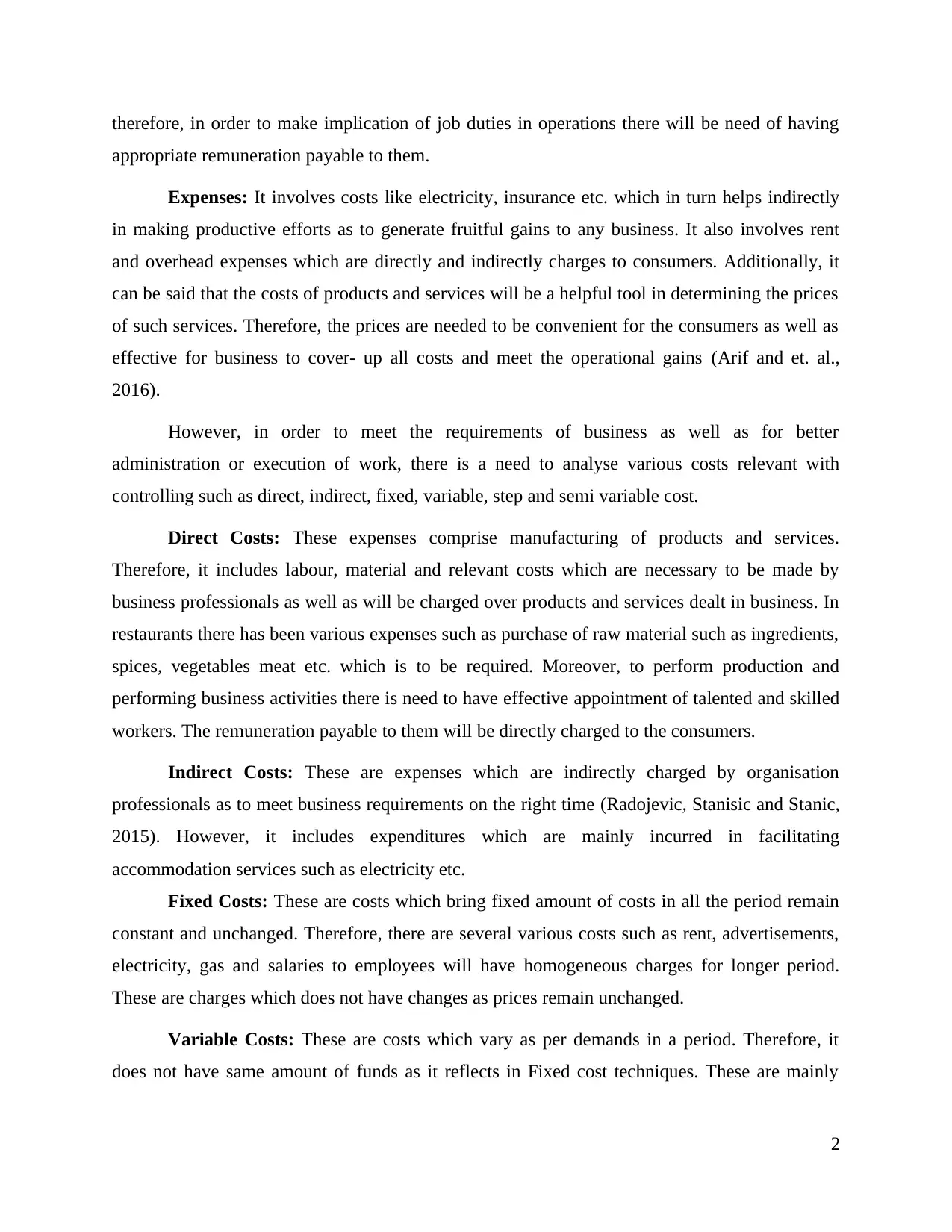
therefore, in order to make implication of job duties in operations there will be need of having
appropriate remuneration payable to them.
Expenses: It involves costs like electricity, insurance etc. which in turn helps indirectly
in making productive efforts as to generate fruitful gains to any business. It also involves rent
and overhead expenses which are directly and indirectly charges to consumers. Additionally, it
can be said that the costs of products and services will be a helpful tool in determining the prices
of such services. Therefore, the prices are needed to be convenient for the consumers as well as
effective for business to cover- up all costs and meet the operational gains (Arif and et. al.,
2016).
However, in order to meet the requirements of business as well as for better
administration or execution of work, there is a need to analyse various costs relevant with
controlling such as direct, indirect, fixed, variable, step and semi variable cost.
Direct Costs: These expenses comprise manufacturing of products and services.
Therefore, it includes labour, material and relevant costs which are necessary to be made by
business professionals as well as will be charged over products and services dealt in business. In
restaurants there has been various expenses such as purchase of raw material such as ingredients,
spices, vegetables meat etc. which is to be required. Moreover, to perform production and
performing business activities there is need to have effective appointment of talented and skilled
workers. The remuneration payable to them will be directly charged to the consumers.
Indirect Costs: These are expenses which are indirectly charged by organisation
professionals as to meet business requirements on the right time (Radojevic, Stanisic and Stanic,
2015). However, it includes expenditures which are mainly incurred in facilitating
accommodation services such as electricity etc.
Fixed Costs: These are costs which bring fixed amount of costs in all the period remain
constant and unchanged. Therefore, there are several various costs such as rent, advertisements,
electricity, gas and salaries to employees will have homogeneous charges for longer period.
These are charges which does not have changes as prices remain unchanged.
Variable Costs: These are costs which vary as per demands in a period. Therefore, it
does not have same amount of funds as it reflects in Fixed cost techniques. These are mainly
2
appropriate remuneration payable to them.
Expenses: It involves costs like electricity, insurance etc. which in turn helps indirectly
in making productive efforts as to generate fruitful gains to any business. It also involves rent
and overhead expenses which are directly and indirectly charges to consumers. Additionally, it
can be said that the costs of products and services will be a helpful tool in determining the prices
of such services. Therefore, the prices are needed to be convenient for the consumers as well as
effective for business to cover- up all costs and meet the operational gains (Arif and et. al.,
2016).
However, in order to meet the requirements of business as well as for better
administration or execution of work, there is a need to analyse various costs relevant with
controlling such as direct, indirect, fixed, variable, step and semi variable cost.
Direct Costs: These expenses comprise manufacturing of products and services.
Therefore, it includes labour, material and relevant costs which are necessary to be made by
business professionals as well as will be charged over products and services dealt in business. In
restaurants there has been various expenses such as purchase of raw material such as ingredients,
spices, vegetables meat etc. which is to be required. Moreover, to perform production and
performing business activities there is need to have effective appointment of talented and skilled
workers. The remuneration payable to them will be directly charged to the consumers.
Indirect Costs: These are expenses which are indirectly charged by organisation
professionals as to meet business requirements on the right time (Radojevic, Stanisic and Stanic,
2015). However, it includes expenditures which are mainly incurred in facilitating
accommodation services such as electricity etc.
Fixed Costs: These are costs which bring fixed amount of costs in all the period remain
constant and unchanged. Therefore, there are several various costs such as rent, advertisements,
electricity, gas and salaries to employees will have homogeneous charges for longer period.
These are charges which does not have changes as prices remain unchanged.
Variable Costs: These are costs which vary as per demands in a period. Therefore, it
does not have same amount of funds as it reflects in Fixed cost techniques. These are mainly
2
Paraphrase This Document
Need a fresh take? Get an instant paraphrase of this document with our AI Paraphraser
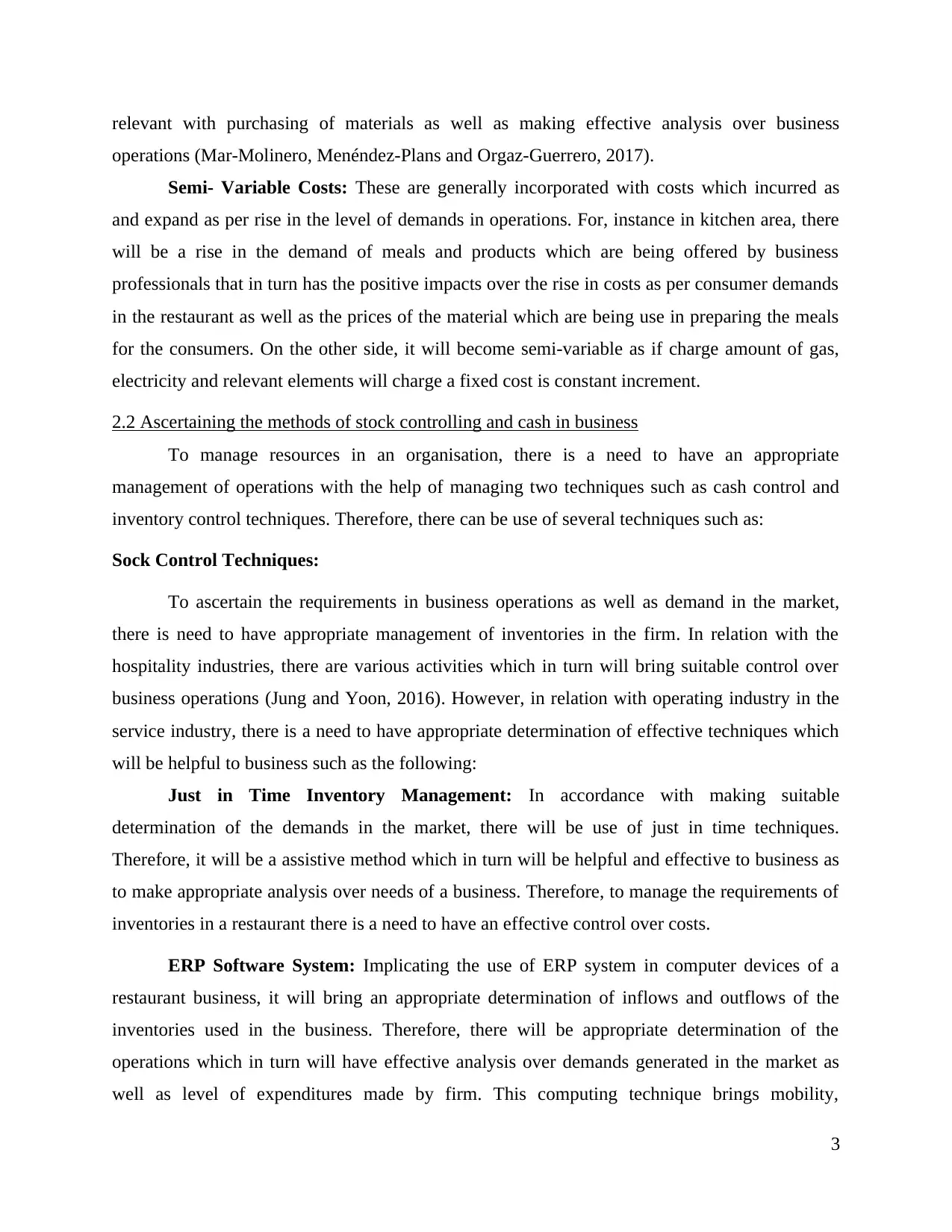
relevant with purchasing of materials as well as making effective analysis over business
operations (Mar-Molinero, Menéndez-Plans and Orgaz-Guerrero, 2017).
Semi- Variable Costs: These are generally incorporated with costs which incurred as
and expand as per rise in the level of demands in operations. For, instance in kitchen area, there
will be a rise in the demand of meals and products which are being offered by business
professionals that in turn has the positive impacts over the rise in costs as per consumer demands
in the restaurant as well as the prices of the material which are being use in preparing the meals
for the consumers. On the other side, it will become semi-variable as if charge amount of gas,
electricity and relevant elements will charge a fixed cost is constant increment.
2.2 Ascertaining the methods of stock controlling and cash in business
To manage resources in an organisation, there is a need to have an appropriate
management of operations with the help of managing two techniques such as cash control and
inventory control techniques. Therefore, there can be use of several techniques such as:
Sock Control Techniques:
To ascertain the requirements in business operations as well as demand in the market,
there is need to have appropriate management of inventories in the firm. In relation with the
hospitality industries, there are various activities which in turn will bring suitable control over
business operations (Jung and Yoon, 2016). However, in relation with operating industry in the
service industry, there is a need to have appropriate determination of effective techniques which
will be helpful to business such as the following:
Just in Time Inventory Management: In accordance with making suitable
determination of the demands in the market, there will be use of just in time techniques.
Therefore, it will be a assistive method which in turn will be helpful and effective to business as
to make appropriate analysis over needs of a business. Therefore, to manage the requirements of
inventories in a restaurant there is a need to have an effective control over costs.
ERP Software System: Implicating the use of ERP system in computer devices of a
restaurant business, it will bring an appropriate determination of inflows and outflows of the
inventories used in the business. Therefore, there will be appropriate determination of the
operations which in turn will have effective analysis over demands generated in the market as
well as level of expenditures made by firm. This computing technique brings mobility,
3
operations (Mar-Molinero, Menéndez-Plans and Orgaz-Guerrero, 2017).
Semi- Variable Costs: These are generally incorporated with costs which incurred as
and expand as per rise in the level of demands in operations. For, instance in kitchen area, there
will be a rise in the demand of meals and products which are being offered by business
professionals that in turn has the positive impacts over the rise in costs as per consumer demands
in the restaurant as well as the prices of the material which are being use in preparing the meals
for the consumers. On the other side, it will become semi-variable as if charge amount of gas,
electricity and relevant elements will charge a fixed cost is constant increment.
2.2 Ascertaining the methods of stock controlling and cash in business
To manage resources in an organisation, there is a need to have an appropriate
management of operations with the help of managing two techniques such as cash control and
inventory control techniques. Therefore, there can be use of several techniques such as:
Sock Control Techniques:
To ascertain the requirements in business operations as well as demand in the market,
there is need to have appropriate management of inventories in the firm. In relation with the
hospitality industries, there are various activities which in turn will bring suitable control over
business operations (Jung and Yoon, 2016). However, in relation with operating industry in the
service industry, there is a need to have appropriate determination of effective techniques which
will be helpful to business such as the following:
Just in Time Inventory Management: In accordance with making suitable
determination of the demands in the market, there will be use of just in time techniques.
Therefore, it will be a assistive method which in turn will be helpful and effective to business as
to make appropriate analysis over needs of a business. Therefore, to manage the requirements of
inventories in a restaurant there is a need to have an effective control over costs.
ERP Software System: Implicating the use of ERP system in computer devices of a
restaurant business, it will bring an appropriate determination of inflows and outflows of the
inventories used in the business. Therefore, there will be appropriate determination of the
operations which in turn will have effective analysis over demands generated in the market as
well as level of expenditures made by firm. This computing technique brings mobility,
3
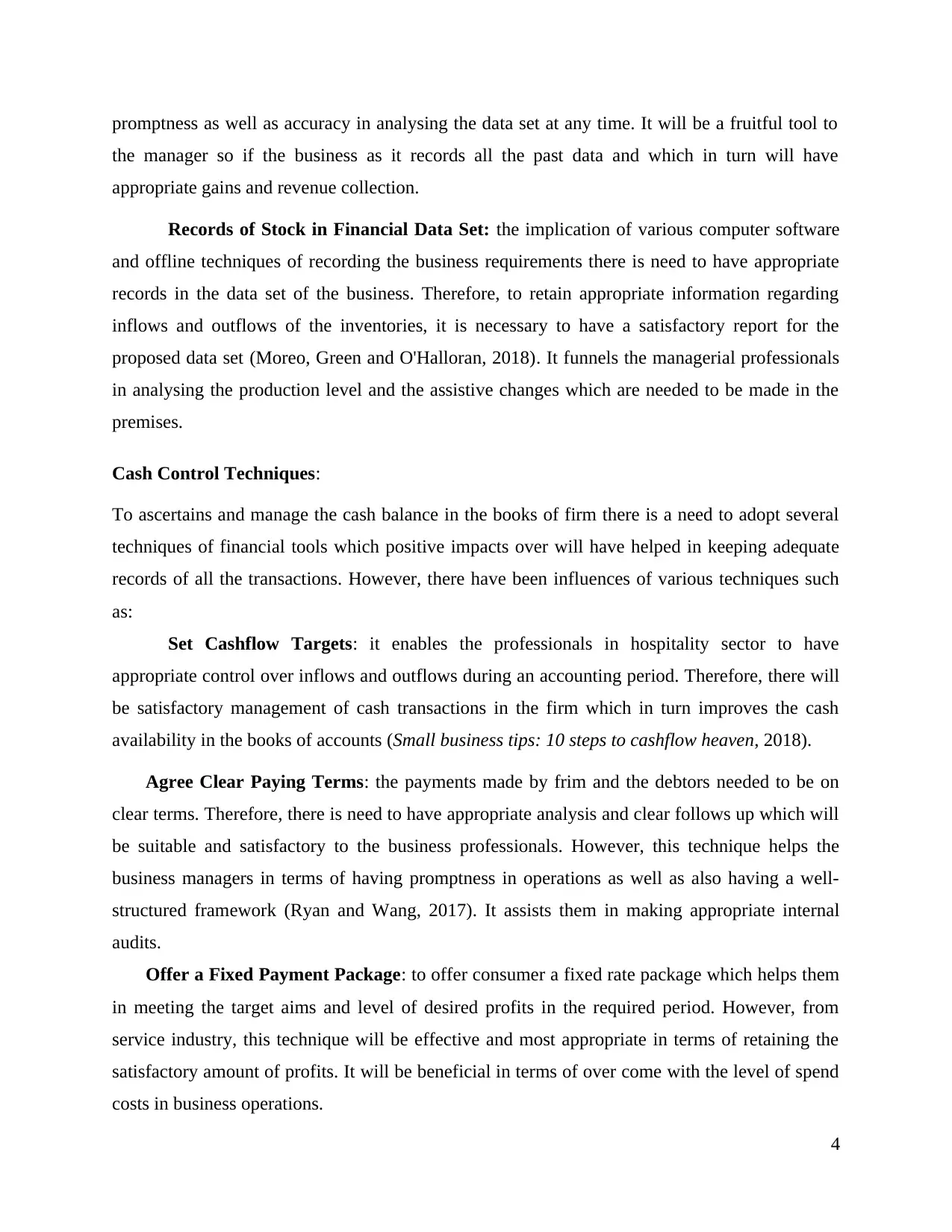
promptness as well as accuracy in analysing the data set at any time. It will be a fruitful tool to
the manager so if the business as it records all the past data and which in turn will have
appropriate gains and revenue collection.
Records of Stock in Financial Data Set: the implication of various computer software
and offline techniques of recording the business requirements there is need to have appropriate
records in the data set of the business. Therefore, to retain appropriate information regarding
inflows and outflows of the inventories, it is necessary to have a satisfactory report for the
proposed data set (Moreo, Green and O'Halloran, 2018). It funnels the managerial professionals
in analysing the production level and the assistive changes which are needed to be made in the
premises.
Cash Control Techniques:
To ascertains and manage the cash balance in the books of firm there is a need to adopt several
techniques of financial tools which positive impacts over will have helped in keeping adequate
records of all the transactions. However, there have been influences of various techniques such
as:
Set Cashflow Targets: it enables the professionals in hospitality sector to have
appropriate control over inflows and outflows during an accounting period. Therefore, there will
be satisfactory management of cash transactions in the firm which in turn improves the cash
availability in the books of accounts (Small business tips: 10 steps to cashflow heaven, 2018).
Agree Clear Paying Terms: the payments made by frim and the debtors needed to be on
clear terms. Therefore, there is need to have appropriate analysis and clear follows up which will
be suitable and satisfactory to the business professionals. However, this technique helps the
business managers in terms of having promptness in operations as well as also having a well-
structured framework (Ryan and Wang, 2017). It assists them in making appropriate internal
audits.
Offer a Fixed Payment Package: to offer consumer a fixed rate package which helps them
in meeting the target aims and level of desired profits in the required period. However, from
service industry, this technique will be effective and most appropriate in terms of retaining the
satisfactory amount of profits. It will be beneficial in terms of over come with the level of spend
costs in business operations.
4
the manager so if the business as it records all the past data and which in turn will have
appropriate gains and revenue collection.
Records of Stock in Financial Data Set: the implication of various computer software
and offline techniques of recording the business requirements there is need to have appropriate
records in the data set of the business. Therefore, to retain appropriate information regarding
inflows and outflows of the inventories, it is necessary to have a satisfactory report for the
proposed data set (Moreo, Green and O'Halloran, 2018). It funnels the managerial professionals
in analysing the production level and the assistive changes which are needed to be made in the
premises.
Cash Control Techniques:
To ascertains and manage the cash balance in the books of firm there is a need to adopt several
techniques of financial tools which positive impacts over will have helped in keeping adequate
records of all the transactions. However, there have been influences of various techniques such
as:
Set Cashflow Targets: it enables the professionals in hospitality sector to have
appropriate control over inflows and outflows during an accounting period. Therefore, there will
be satisfactory management of cash transactions in the firm which in turn improves the cash
availability in the books of accounts (Small business tips: 10 steps to cashflow heaven, 2018).
Agree Clear Paying Terms: the payments made by frim and the debtors needed to be on
clear terms. Therefore, there is need to have appropriate analysis and clear follows up which will
be suitable and satisfactory to the business professionals. However, this technique helps the
business managers in terms of having promptness in operations as well as also having a well-
structured framework (Ryan and Wang, 2017). It assists them in making appropriate internal
audits.
Offer a Fixed Payment Package: to offer consumer a fixed rate package which helps them
in meeting the target aims and level of desired profits in the required period. However, from
service industry, this technique will be effective and most appropriate in terms of retaining the
satisfactory amount of profits. It will be beneficial in terms of over come with the level of spend
costs in business operations.
4
⊘ This is a preview!⊘
Do you want full access?
Subscribe today to unlock all pages.

Trusted by 1+ million students worldwide
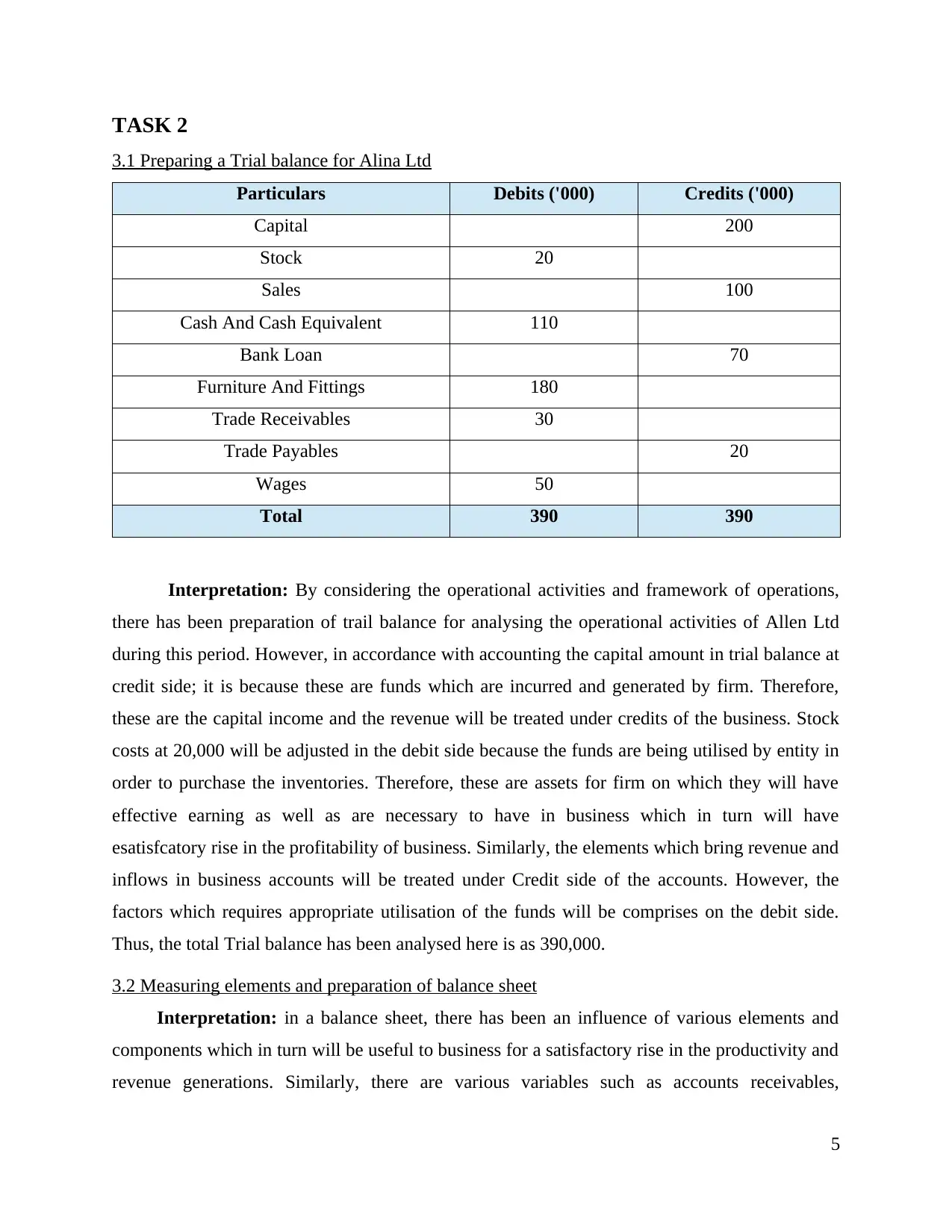
TASK 2
3.1 Preparing a Trial balance for Alina Ltd
Particulars Debits ('000) Credits ('000)
Capital 200
Stock 20
Sales 100
Cash And Cash Equivalent 110
Bank Loan 70
Furniture And Fittings 180
Trade Receivables 30
Trade Payables 20
Wages 50
Total 390 390
Interpretation: By considering the operational activities and framework of operations,
there has been preparation of trail balance for analysing the operational activities of Allen Ltd
during this period. However, in accordance with accounting the capital amount in trial balance at
credit side; it is because these are funds which are incurred and generated by firm. Therefore,
these are the capital income and the revenue will be treated under credits of the business. Stock
costs at 20,000 will be adjusted in the debit side because the funds are being utilised by entity in
order to purchase the inventories. Therefore, these are assets for firm on which they will have
effective earning as well as are necessary to have in business which in turn will have
esatisfcatory rise in the profitability of business. Similarly, the elements which bring revenue and
inflows in business accounts will be treated under Credit side of the accounts. However, the
factors which requires appropriate utilisation of the funds will be comprises on the debit side.
Thus, the total Trial balance has been analysed here is as 390,000.
3.2 Measuring elements and preparation of balance sheet
Interpretation: in a balance sheet, there has been an influence of various elements and
components which in turn will be useful to business for a satisfactory rise in the productivity and
revenue generations. Similarly, there are various variables such as accounts receivables,
5
3.1 Preparing a Trial balance for Alina Ltd
Particulars Debits ('000) Credits ('000)
Capital 200
Stock 20
Sales 100
Cash And Cash Equivalent 110
Bank Loan 70
Furniture And Fittings 180
Trade Receivables 30
Trade Payables 20
Wages 50
Total 390 390
Interpretation: By considering the operational activities and framework of operations,
there has been preparation of trail balance for analysing the operational activities of Allen Ltd
during this period. However, in accordance with accounting the capital amount in trial balance at
credit side; it is because these are funds which are incurred and generated by firm. Therefore,
these are the capital income and the revenue will be treated under credits of the business. Stock
costs at 20,000 will be adjusted in the debit side because the funds are being utilised by entity in
order to purchase the inventories. Therefore, these are assets for firm on which they will have
effective earning as well as are necessary to have in business which in turn will have
esatisfcatory rise in the profitability of business. Similarly, the elements which bring revenue and
inflows in business accounts will be treated under Credit side of the accounts. However, the
factors which requires appropriate utilisation of the funds will be comprises on the debit side.
Thus, the total Trial balance has been analysed here is as 390,000.
3.2 Measuring elements and preparation of balance sheet
Interpretation: in a balance sheet, there has been an influence of various elements and
components which in turn will be useful to business for a satisfactory rise in the productivity and
revenue generations. Similarly, there are various variables such as accounts receivables,
5
Paraphrase This Document
Need a fresh take? Get an instant paraphrase of this document with our AI Paraphraser
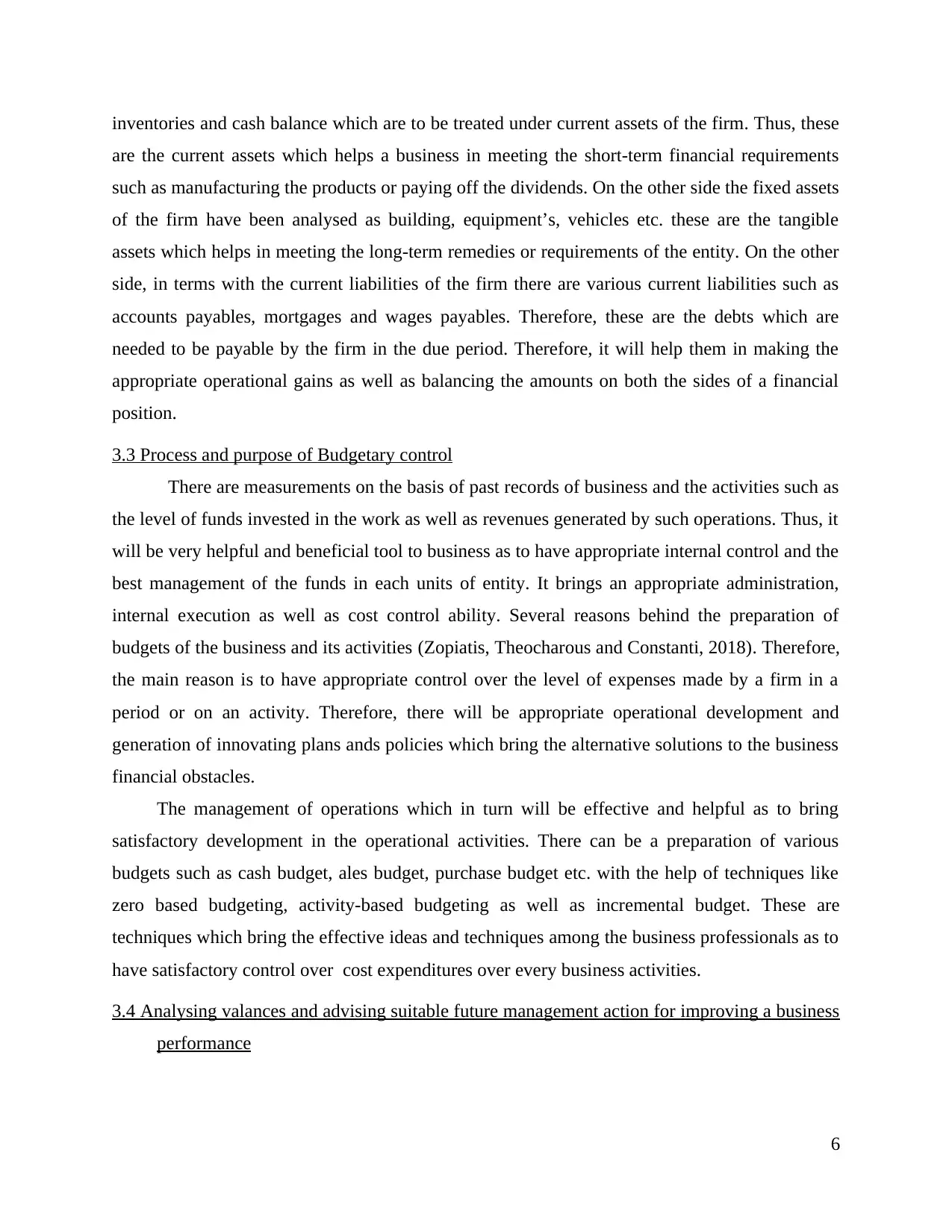
inventories and cash balance which are to be treated under current assets of the firm. Thus, these
are the current assets which helps a business in meeting the short-term financial requirements
such as manufacturing the products or paying off the dividends. On the other side the fixed assets
of the firm have been analysed as building, equipment’s, vehicles etc. these are the tangible
assets which helps in meeting the long-term remedies or requirements of the entity. On the other
side, in terms with the current liabilities of the firm there are various current liabilities such as
accounts payables, mortgages and wages payables. Therefore, these are the debts which are
needed to be payable by the firm in the due period. Therefore, it will help them in making the
appropriate operational gains as well as balancing the amounts on both the sides of a financial
position.
3.3 Process and purpose of Budgetary control
There are measurements on the basis of past records of business and the activities such as
the level of funds invested in the work as well as revenues generated by such operations. Thus, it
will be very helpful and beneficial tool to business as to have appropriate internal control and the
best management of the funds in each units of entity. It brings an appropriate administration,
internal execution as well as cost control ability. Several reasons behind the preparation of
budgets of the business and its activities (Zopiatis, Theocharous and Constanti, 2018). Therefore,
the main reason is to have appropriate control over the level of expenses made by a firm in a
period or on an activity. Therefore, there will be appropriate operational development and
generation of innovating plans ands policies which bring the alternative solutions to the business
financial obstacles.
The management of operations which in turn will be effective and helpful as to bring
satisfactory development in the operational activities. There can be a preparation of various
budgets such as cash budget, ales budget, purchase budget etc. with the help of techniques like
zero based budgeting, activity-based budgeting as well as incremental budget. These are
techniques which bring the effective ideas and techniques among the business professionals as to
have satisfactory control over cost expenditures over every business activities.
3.4 Analysing valances and advising suitable future management action for improving a business
performance
6
are the current assets which helps a business in meeting the short-term financial requirements
such as manufacturing the products or paying off the dividends. On the other side the fixed assets
of the firm have been analysed as building, equipment’s, vehicles etc. these are the tangible
assets which helps in meeting the long-term remedies or requirements of the entity. On the other
side, in terms with the current liabilities of the firm there are various current liabilities such as
accounts payables, mortgages and wages payables. Therefore, these are the debts which are
needed to be payable by the firm in the due period. Therefore, it will help them in making the
appropriate operational gains as well as balancing the amounts on both the sides of a financial
position.
3.3 Process and purpose of Budgetary control
There are measurements on the basis of past records of business and the activities such as
the level of funds invested in the work as well as revenues generated by such operations. Thus, it
will be very helpful and beneficial tool to business as to have appropriate internal control and the
best management of the funds in each units of entity. It brings an appropriate administration,
internal execution as well as cost control ability. Several reasons behind the preparation of
budgets of the business and its activities (Zopiatis, Theocharous and Constanti, 2018). Therefore,
the main reason is to have appropriate control over the level of expenses made by a firm in a
period or on an activity. Therefore, there will be appropriate operational development and
generation of innovating plans ands policies which bring the alternative solutions to the business
financial obstacles.
The management of operations which in turn will be effective and helpful as to bring
satisfactory development in the operational activities. There can be a preparation of various
budgets such as cash budget, ales budget, purchase budget etc. with the help of techniques like
zero based budgeting, activity-based budgeting as well as incremental budget. These are
techniques which bring the effective ideas and techniques among the business professionals as to
have satisfactory control over cost expenditures over every business activities.
3.4 Analysing valances and advising suitable future management action for improving a business
performance
6
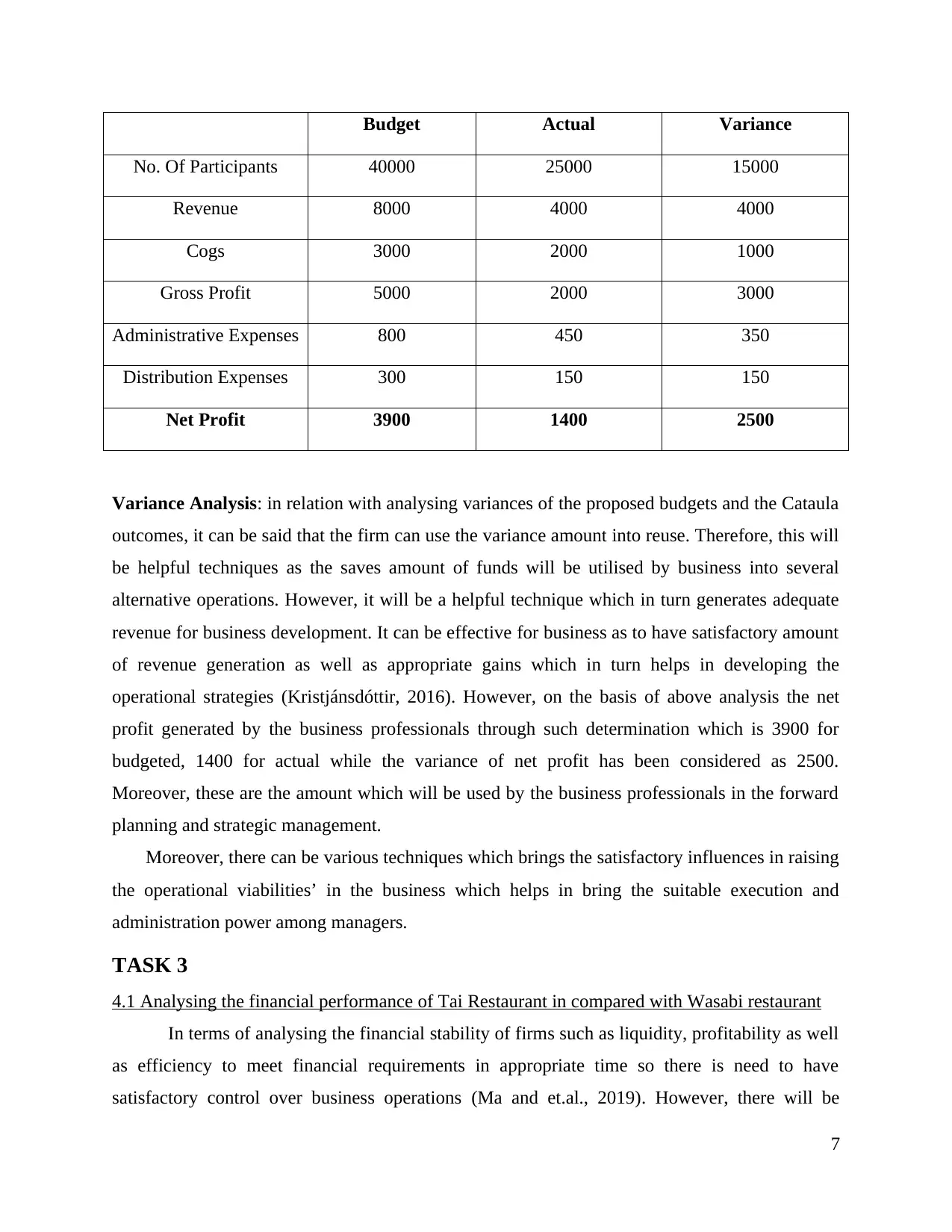
Budget Actual Variance
No. Of Participants 40000 25000 15000
Revenue 8000 4000 4000
Cogs 3000 2000 1000
Gross Profit 5000 2000 3000
Administrative Expenses 800 450 350
Distribution Expenses 300 150 150
Net Profit 3900 1400 2500
Variance Analysis: in relation with analysing variances of the proposed budgets and the Cataula
outcomes, it can be said that the firm can use the variance amount into reuse. Therefore, this will
be helpful techniques as the saves amount of funds will be utilised by business into several
alternative operations. However, it will be a helpful technique which in turn generates adequate
revenue for business development. It can be effective for business as to have satisfactory amount
of revenue generation as well as appropriate gains which in turn helps in developing the
operational strategies (Kristjánsdóttir, 2016). However, on the basis of above analysis the net
profit generated by the business professionals through such determination which is 3900 for
budgeted, 1400 for actual while the variance of net profit has been considered as 2500.
Moreover, these are the amount which will be used by the business professionals in the forward
planning and strategic management.
Moreover, there can be various techniques which brings the satisfactory influences in raising
the operational viabilities’ in the business which helps in bring the suitable execution and
administration power among managers.
TASK 3
4.1 Analysing the financial performance of Tai Restaurant in compared with Wasabi restaurant
In terms of analysing the financial stability of firms such as liquidity, profitability as well
as efficiency to meet financial requirements in appropriate time so there is need to have
satisfactory control over business operations (Ma and et.al., 2019). However, there will be
7
No. Of Participants 40000 25000 15000
Revenue 8000 4000 4000
Cogs 3000 2000 1000
Gross Profit 5000 2000 3000
Administrative Expenses 800 450 350
Distribution Expenses 300 150 150
Net Profit 3900 1400 2500
Variance Analysis: in relation with analysing variances of the proposed budgets and the Cataula
outcomes, it can be said that the firm can use the variance amount into reuse. Therefore, this will
be helpful techniques as the saves amount of funds will be utilised by business into several
alternative operations. However, it will be a helpful technique which in turn generates adequate
revenue for business development. It can be effective for business as to have satisfactory amount
of revenue generation as well as appropriate gains which in turn helps in developing the
operational strategies (Kristjánsdóttir, 2016). However, on the basis of above analysis the net
profit generated by the business professionals through such determination which is 3900 for
budgeted, 1400 for actual while the variance of net profit has been considered as 2500.
Moreover, these are the amount which will be used by the business professionals in the forward
planning and strategic management.
Moreover, there can be various techniques which brings the satisfactory influences in raising
the operational viabilities’ in the business which helps in bring the suitable execution and
administration power among managers.
TASK 3
4.1 Analysing the financial performance of Tai Restaurant in compared with Wasabi restaurant
In terms of analysing the financial stability of firms such as liquidity, profitability as well
as efficiency to meet financial requirements in appropriate time so there is need to have
satisfactory control over business operations (Ma and et.al., 2019). However, there will be
7
⊘ This is a preview!⊘
Do you want full access?
Subscribe today to unlock all pages.

Trusted by 1+ million students worldwide
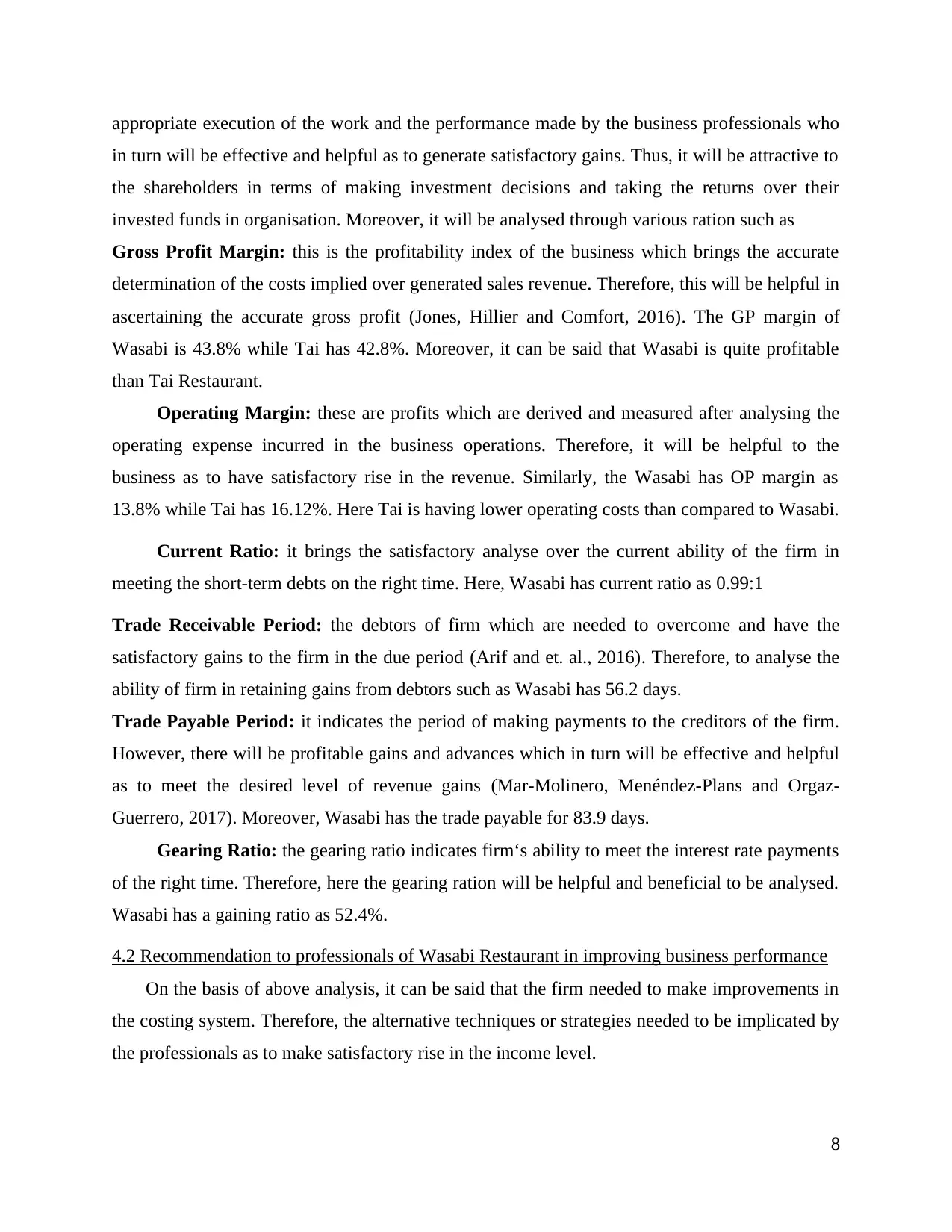
appropriate execution of the work and the performance made by the business professionals who
in turn will be effective and helpful as to generate satisfactory gains. Thus, it will be attractive to
the shareholders in terms of making investment decisions and taking the returns over their
invested funds in organisation. Moreover, it will be analysed through various ration such as
Gross Profit Margin: this is the profitability index of the business which brings the accurate
determination of the costs implied over generated sales revenue. Therefore, this will be helpful in
ascertaining the accurate gross profit (Jones, Hillier and Comfort, 2016). The GP margin of
Wasabi is 43.8% while Tai has 42.8%. Moreover, it can be said that Wasabi is quite profitable
than Tai Restaurant.
Operating Margin: these are profits which are derived and measured after analysing the
operating expense incurred in the business operations. Therefore, it will be helpful to the
business as to have satisfactory rise in the revenue. Similarly, the Wasabi has OP margin as
13.8% while Tai has 16.12%. Here Tai is having lower operating costs than compared to Wasabi.
Current Ratio: it brings the satisfactory analyse over the current ability of the firm in
meeting the short-term debts on the right time. Here, Wasabi has current ratio as 0.99:1
Trade Receivable Period: the debtors of firm which are needed to overcome and have the
satisfactory gains to the firm in the due period (Arif and et. al., 2016). Therefore, to analyse the
ability of firm in retaining gains from debtors such as Wasabi has 56.2 days.
Trade Payable Period: it indicates the period of making payments to the creditors of the firm.
However, there will be profitable gains and advances which in turn will be effective and helpful
as to meet the desired level of revenue gains (Mar-Molinero, Menéndez-Plans and Orgaz-
Guerrero, 2017). Moreover, Wasabi has the trade payable for 83.9 days.
Gearing Ratio: the gearing ratio indicates firm‘s ability to meet the interest rate payments
of the right time. Therefore, here the gearing ration will be helpful and beneficial to be analysed.
Wasabi has a gaining ratio as 52.4%.
4.2 Recommendation to professionals of Wasabi Restaurant in improving business performance
On the basis of above analysis, it can be said that the firm needed to make improvements in
the costing system. Therefore, the alternative techniques or strategies needed to be implicated by
the professionals as to make satisfactory rise in the income level.
8
in turn will be effective and helpful as to generate satisfactory gains. Thus, it will be attractive to
the shareholders in terms of making investment decisions and taking the returns over their
invested funds in organisation. Moreover, it will be analysed through various ration such as
Gross Profit Margin: this is the profitability index of the business which brings the accurate
determination of the costs implied over generated sales revenue. Therefore, this will be helpful in
ascertaining the accurate gross profit (Jones, Hillier and Comfort, 2016). The GP margin of
Wasabi is 43.8% while Tai has 42.8%. Moreover, it can be said that Wasabi is quite profitable
than Tai Restaurant.
Operating Margin: these are profits which are derived and measured after analysing the
operating expense incurred in the business operations. Therefore, it will be helpful to the
business as to have satisfactory rise in the revenue. Similarly, the Wasabi has OP margin as
13.8% while Tai has 16.12%. Here Tai is having lower operating costs than compared to Wasabi.
Current Ratio: it brings the satisfactory analyse over the current ability of the firm in
meeting the short-term debts on the right time. Here, Wasabi has current ratio as 0.99:1
Trade Receivable Period: the debtors of firm which are needed to overcome and have the
satisfactory gains to the firm in the due period (Arif and et. al., 2016). Therefore, to analyse the
ability of firm in retaining gains from debtors such as Wasabi has 56.2 days.
Trade Payable Period: it indicates the period of making payments to the creditors of the firm.
However, there will be profitable gains and advances which in turn will be effective and helpful
as to meet the desired level of revenue gains (Mar-Molinero, Menéndez-Plans and Orgaz-
Guerrero, 2017). Moreover, Wasabi has the trade payable for 83.9 days.
Gearing Ratio: the gearing ratio indicates firm‘s ability to meet the interest rate payments
of the right time. Therefore, here the gearing ration will be helpful and beneficial to be analysed.
Wasabi has a gaining ratio as 52.4%.
4.2 Recommendation to professionals of Wasabi Restaurant in improving business performance
On the basis of above analysis, it can be said that the firm needed to make improvements in
the costing system. Therefore, the alternative techniques or strategies needed to be implicated by
the professionals as to make satisfactory rise in the income level.
8
Paraphrase This Document
Need a fresh take? Get an instant paraphrase of this document with our AI Paraphraser
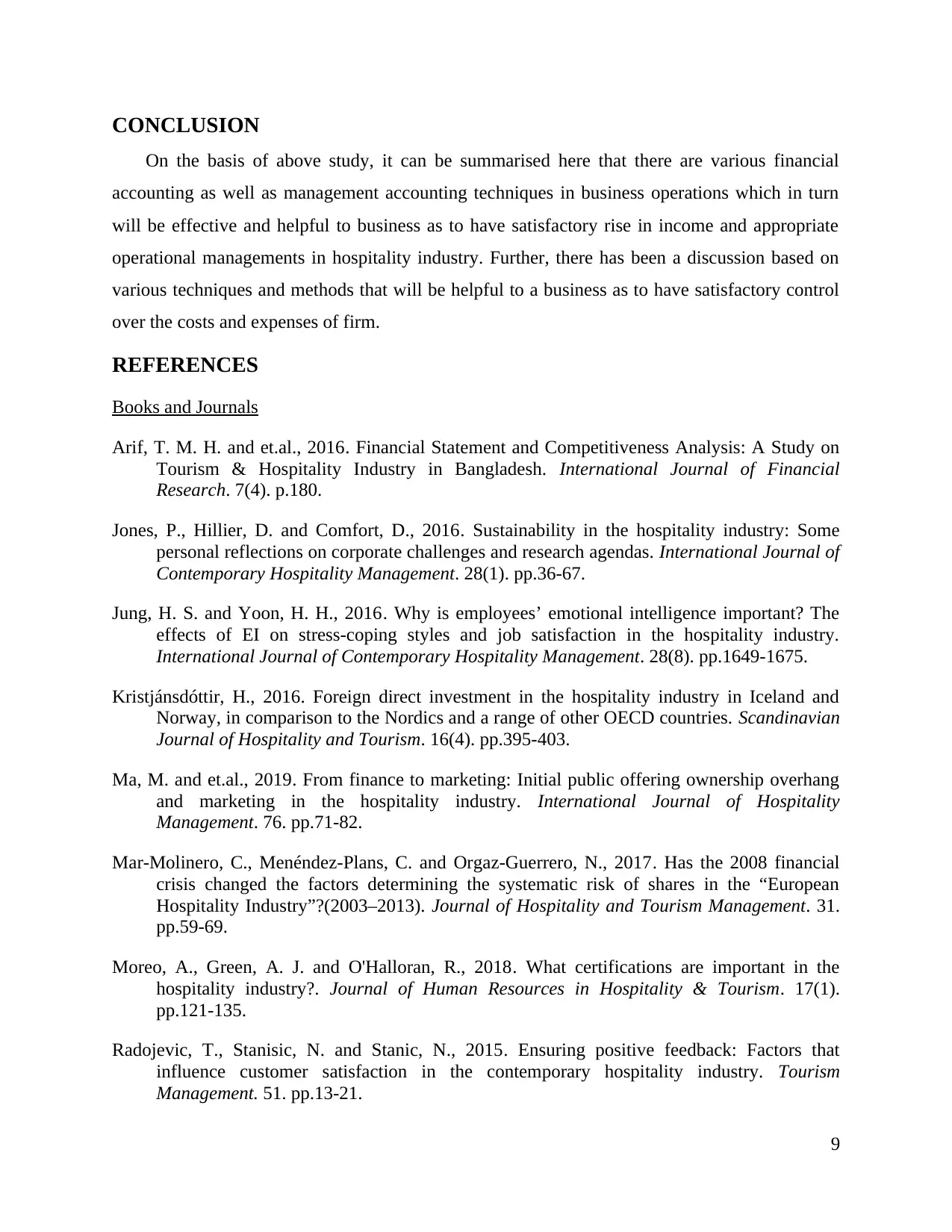
CONCLUSION
On the basis of above study, it can be summarised here that there are various financial
accounting as well as management accounting techniques in business operations which in turn
will be effective and helpful to business as to have satisfactory rise in income and appropriate
operational managements in hospitality industry. Further, there has been a discussion based on
various techniques and methods that will be helpful to a business as to have satisfactory control
over the costs and expenses of firm.
REFERENCES
Books and Journals
Arif, T. M. H. and et.al., 2016. Financial Statement and Competitiveness Analysis: A Study on
Tourism & Hospitality Industry in Bangladesh. International Journal of Financial
Research. 7(4). p.180.
Jones, P., Hillier, D. and Comfort, D., 2016. Sustainability in the hospitality industry: Some
personal reflections on corporate challenges and research agendas. International Journal of
Contemporary Hospitality Management. 28(1). pp.36-67.
Jung, H. S. and Yoon, H. H., 2016. Why is employees’ emotional intelligence important? The
effects of EI on stress-coping styles and job satisfaction in the hospitality industry.
International Journal of Contemporary Hospitality Management. 28(8). pp.1649-1675.
Kristjánsdóttir, H., 2016. Foreign direct investment in the hospitality industry in Iceland and
Norway, in comparison to the Nordics and a range of other OECD countries. Scandinavian
Journal of Hospitality and Tourism. 16(4). pp.395-403.
Ma, M. and et.al., 2019. From finance to marketing: Initial public offering ownership overhang
and marketing in the hospitality industry. International Journal of Hospitality
Management. 76. pp.71-82.
Mar-Molinero, C., Menéndez-Plans, C. and Orgaz-Guerrero, N., 2017. Has the 2008 financial
crisis changed the factors determining the systematic risk of shares in the “European
Hospitality Industry”?(2003–2013). Journal of Hospitality and Tourism Management. 31.
pp.59-69.
Moreo, A., Green, A. J. and O'Halloran, R., 2018. What certifications are important in the
hospitality industry?. Journal of Human Resources in Hospitality & Tourism. 17(1).
pp.121-135.
Radojevic, T., Stanisic, N. and Stanic, N., 2015. Ensuring positive feedback: Factors that
influence customer satisfaction in the contemporary hospitality industry. Tourism
Management. 51. pp.13-21.
9
On the basis of above study, it can be summarised here that there are various financial
accounting as well as management accounting techniques in business operations which in turn
will be effective and helpful to business as to have satisfactory rise in income and appropriate
operational managements in hospitality industry. Further, there has been a discussion based on
various techniques and methods that will be helpful to a business as to have satisfactory control
over the costs and expenses of firm.
REFERENCES
Books and Journals
Arif, T. M. H. and et.al., 2016. Financial Statement and Competitiveness Analysis: A Study on
Tourism & Hospitality Industry in Bangladesh. International Journal of Financial
Research. 7(4). p.180.
Jones, P., Hillier, D. and Comfort, D., 2016. Sustainability in the hospitality industry: Some
personal reflections on corporate challenges and research agendas. International Journal of
Contemporary Hospitality Management. 28(1). pp.36-67.
Jung, H. S. and Yoon, H. H., 2016. Why is employees’ emotional intelligence important? The
effects of EI on stress-coping styles and job satisfaction in the hospitality industry.
International Journal of Contemporary Hospitality Management. 28(8). pp.1649-1675.
Kristjánsdóttir, H., 2016. Foreign direct investment in the hospitality industry in Iceland and
Norway, in comparison to the Nordics and a range of other OECD countries. Scandinavian
Journal of Hospitality and Tourism. 16(4). pp.395-403.
Ma, M. and et.al., 2019. From finance to marketing: Initial public offering ownership overhang
and marketing in the hospitality industry. International Journal of Hospitality
Management. 76. pp.71-82.
Mar-Molinero, C., Menéndez-Plans, C. and Orgaz-Guerrero, N., 2017. Has the 2008 financial
crisis changed the factors determining the systematic risk of shares in the “European
Hospitality Industry”?(2003–2013). Journal of Hospitality and Tourism Management. 31.
pp.59-69.
Moreo, A., Green, A. J. and O'Halloran, R., 2018. What certifications are important in the
hospitality industry?. Journal of Human Resources in Hospitality & Tourism. 17(1).
pp.121-135.
Radojevic, T., Stanisic, N. and Stanic, N., 2015. Ensuring positive feedback: Factors that
influence customer satisfaction in the contemporary hospitality industry. Tourism
Management. 51. pp.13-21.
9
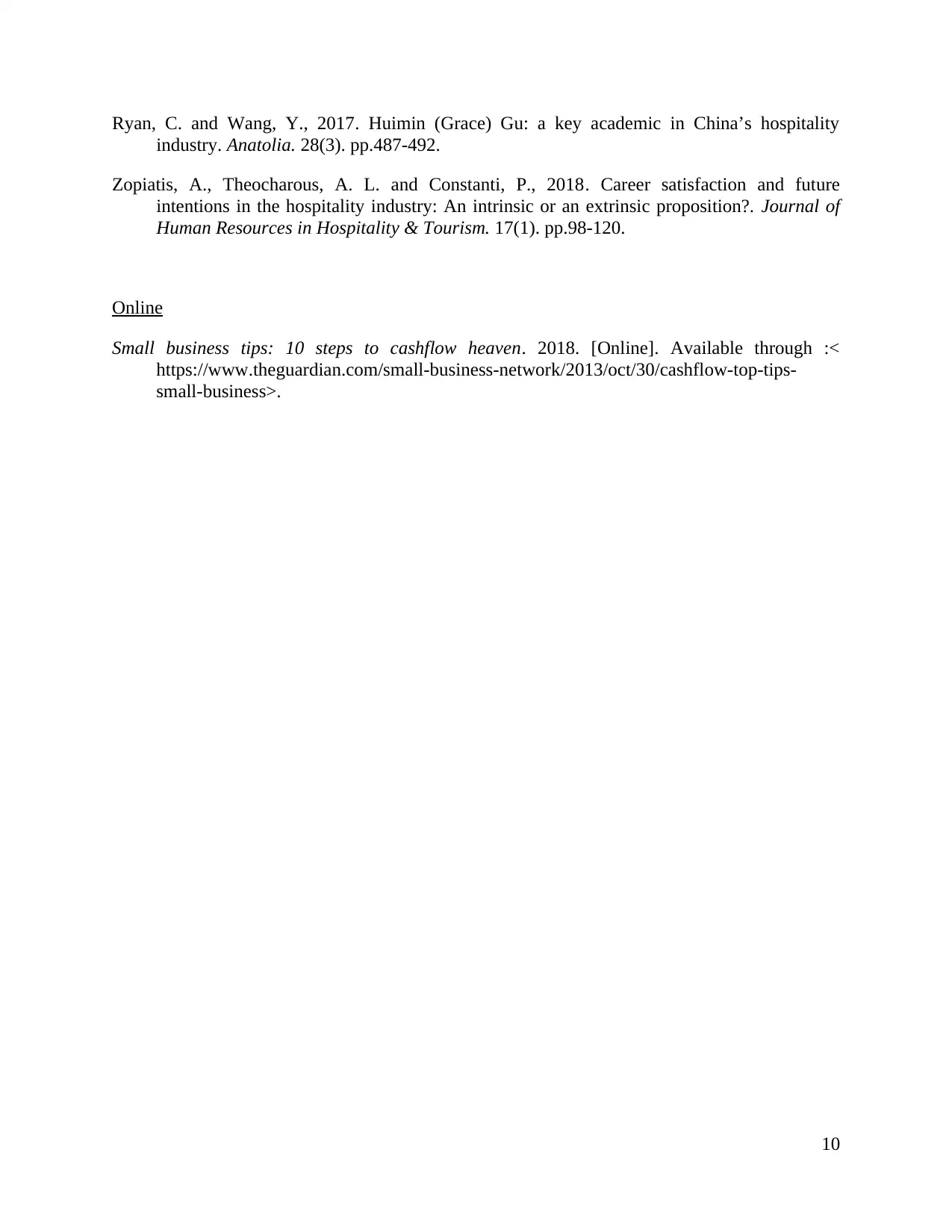
Ryan, C. and Wang, Y., 2017. Huimin (Grace) Gu: a key academic in China’s hospitality
industry. Anatolia. 28(3). pp.487-492.
Zopiatis, A., Theocharous, A. L. and Constanti, P., 2018. Career satisfaction and future
intentions in the hospitality industry: An intrinsic or an extrinsic proposition?. Journal of
Human Resources in Hospitality & Tourism. 17(1). pp.98-120.
Online
Small business tips: 10 steps to cashflow heaven. 2018. [Online]. Available through :<
https://www.theguardian.com/small-business-network/2013/oct/30/cashflow-top-tips-
small-business>.
10
industry. Anatolia. 28(3). pp.487-492.
Zopiatis, A., Theocharous, A. L. and Constanti, P., 2018. Career satisfaction and future
intentions in the hospitality industry: An intrinsic or an extrinsic proposition?. Journal of
Human Resources in Hospitality & Tourism. 17(1). pp.98-120.
Online
Small business tips: 10 steps to cashflow heaven. 2018. [Online]. Available through :<
https://www.theguardian.com/small-business-network/2013/oct/30/cashflow-top-tips-
small-business>.
10
⊘ This is a preview!⊘
Do you want full access?
Subscribe today to unlock all pages.

Trusted by 1+ million students worldwide
1 out of 12
Related Documents
Your All-in-One AI-Powered Toolkit for Academic Success.
+13062052269
info@desklib.com
Available 24*7 on WhatsApp / Email
![[object Object]](/_next/static/media/star-bottom.7253800d.svg)
Unlock your academic potential
Copyright © 2020–2025 A2Z Services. All Rights Reserved. Developed and managed by ZUCOL.




